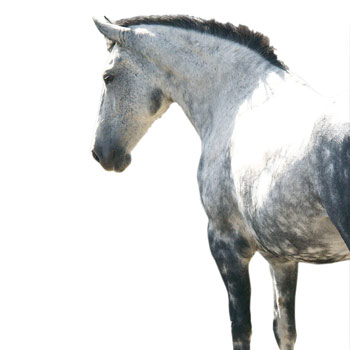If your horse loses his ability to sweat, it can have a serious impact on his health. Here’s what you need to know.
We often take sweating in our horses for granted. In a previous issue (V7I3), we addressed sweating as the most important means for thermoregulatory cooling during exercise, and recovery from exercise. But what happens when a horse loses his ability to produce sweat, a condition termed anhidrosis or dry coat? Is he able to cool himself using other means, or does he run into serious trouble?
What is Anhidrosis?
Anhidrosis comes from the Greek words “an”, which refers to “not” or “lacking”, and “hidrosis”, which means “sweating”. The inability to sweat in both horses and humans has been recognized for centuries.
In horses, the condition develops gradually. About half of affected horses show a typical sequence of events over the course of a few to several days. It is first characterized by profuse sweating (more sweat, longer lasting than usual), followed by less and patchy sweating, and finally a complete or nearly complete absence of sweating. It is not unusual for the horse to continue to secrete sweat in the saddle and bridle areas, under the mane, and in the axillary, inguinal, and perineal areas.
Possible Causes
It’s not known if anhidrosis has any single primary cause. Most veterinarians and researchers believe that many factors combine to cause the condition (Figure 1). The genetic component is based on two observations: family history, and the fact that there are many more unaffected than affected horses living in the same locations and doing the same activities.
The main environmental factor is a hot, humid climate. There are indications that moving from a temperate (cool) climate to a warm, humid climate has an effect, as does general stress, repeated exercise stress (training in particular), chronic dehydration, and fluid/electrolyte imbalance.
All breeds of horse appear to be affected, and there does not appear to be any discrimination by age, gender, intensity of training activity, or color of hair coat.
The Sweat Response
The normal physiological sweating response and the pathology of anhidrosis are compared in Figure 2. Heat is sensed both internally by the hypothalamus (a region in the brain) and externally by the skin. The sensation of heat stimulates the blood vessels in the skin to dilate, increasing blood flow to the skin. The increase in skin temperature results in an increase of sweat formation within the sweat glands, and increased secretion of sweat onto the surface of the skin. This process is assisted by adrenaline, which is secreted by the adrenal gland during normal exercise stress and other types of stress. An increase in blood-borne adrenaline alone is sufficient to stimulate the sweat glands to produce and secrete sweat.
In anhidrotic horses, through means as yet unknown, the sweat glands become dysfunctional. Sweat glands in affected horses seem to be become easily over-stimulated by adrenaline and heat. These over-stimulated glands lose their responsiveness to heat and adrenaline, the sweat-producing cells break down, and the cell debris can block the ducts in the glands.
When anhidrosis first occurs, the impaired sweat production prevents adequate cooling, resulting in increased adrenaline with increased over-stimulation of sweat glands. Damaged sweat glands do not easily repair, and the damage is typically permanent. After some period of recovery, the ability to sweat in warm environments is a function of the amount of damage that has occurred, and the level of stimulation in existing, functional sweat glands. In anhidrotic horses, great care must be taken to prevent repeated situations of sweat gland over-stimulation.
The Impact of Anhidrosis on Thermoregulation and Fluid Balance
In my previous article, I discussed the importance of sweating in a horse’s ability to stay cool. I also considered the importance of maintaining hydration so that thermoregulatory sweating can occur when required.
So what happens when a horse becomes anhidrotic? First, the profuse sweating that occurs with the onset of the condition will cause rapid and pronounced dehydration if rehydration strategies are not used. When working in warm conditions, it is vital to the horse’s well being that the rider be familiar with, and visually monitor, his sweating.
• Is the sweating rate consistent?
• Does the onset of sweating start as early as usual? Does it stop as usual?
• Is the sweating pattern the same as usual and generally all over the main parts of the body?
Deviations from this pattern may indicate something is not right.
When activity levels are maintained in warm, humid conditions, and sweating rates decrease, then horses run the risk of excessive heat stress, or heat strain. The two main sources of heat during activity in warm conditions are the environment and the horse’s actively contracting muscles. The horse can be severely injured in cases of heat strain.
Heat strain is characterized by a rectal temperature of 40oC (104ºF) or higher; hyperventilation or tachypnea (rapid, shallow breathing or panting); high heart rate; and skin that feels hot to the touch. When the rectal temperature is at 40oC (104ºF), the horse’s muscle temperature may be 43oC (109.5ºF) or higher – a temperature at which some muscle proteins may break down. When this happens, many muscle fibers die, resulting in greatly elevated levels of muscle enzymes in the blood. It may take months for a horse to recover from this type of heat strain injury.
If you are concerned that your horse is in, or approaching, a heat strain situation, take strategies to rapidly cool him, including the repeated application of very cold water. Continue to monitor his rectal temperature until it falls to below 39oC (102ºF) and stays there for at least an hour.
Clinical Signs and Diagnosis
If you are concerned your horse may have anhidrosis, it is time to call your vet. When in temperate climates, and when brought into a cooler air-conditioned environment, horses normally reduce their body temperature within 30 to 60 minutes after exercise, depending on the duration and intensity of the exercise and ambient conditions.
The inability to cool out to a rectal temperature of 38ºC (100.5ºF) or less within this time indicates either anhidrosis or severe dehydration. An elevated respiratory rate (tachypnea, 60 to 120 breaths per minute) is a key indicator that anhidrosis may occur or is already present. When this happens, the horse is trying to cool himself by panting, in a manner similar to that used by dogs. His heart rate will also be elevated, indicating an attempt to cool the body by moving hot blood to the skin. Horses that have had anhidrosis for weeks or months may have dry, flaky skin, patchy hair loss (alopecia), no or low energy (lethargy), poor body condition (anorexia), and be off their feed and drinking less water.
The veterinarian may want to conduct a definitive test, something that will stimulate a sweating response in a controlled way. The typical test involves either intravenous or subcutaneous infusion of an adrenergic agonist such as adrenaline or terbutaline. An IV infusion should initiate a rapid sweating response over the entire surface of the horse. If the result is inconsistent and patchy, with low or negligible sweating, then this indicates anhidrosis. When a subcutaneous infusion is used, the veterinarian is testing an area of the skin, such as over the gluteus muscles, where there is normally a strong sweating response. Again if the sweating is patchy or negligible, then this indicates anhidrosis.
Treating Horses with Anhidrosis
There is no definitive treatment that will bring about a cure. Injury to the sweat glands is permanent and an affected horse will remain so for the rest of his life. Therefore, the best approaches for treating an anhidrotic horse involve management practices. Things that can be controlled are:
• The time of year when exercise training and competitive activities are performed (preferably winter months)
• Duration and intensity of exercise
• Minimizing exposure to hot, humid conditions (use shading, air movement, air conditioning)
• Maintaining the correct water and electrolyte balance. Horses that do poorly need to be taken off work and kept in cooler conditions, with careful monitoring of water, electrolytes, feed intake and body condition. With proper care, however, anhidrotic horses can lead healthy and productive lives.
Dr. Mike Lindinger has been studying hydration and fluid balance in horses for 20 years. He has published numerous scientific articles and book chapters on this topic. He was involved in the development of Perform’N Win electrolyte supplement for horses, the Equistat hydration monitor, and the On to Atlanta heat stress research studies at the University of Guelph.








